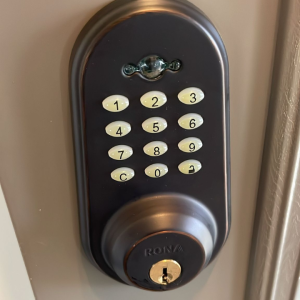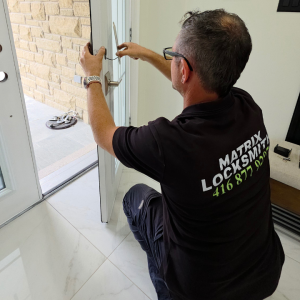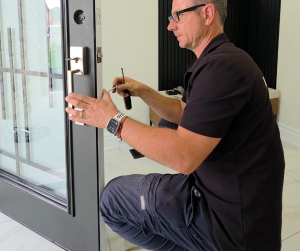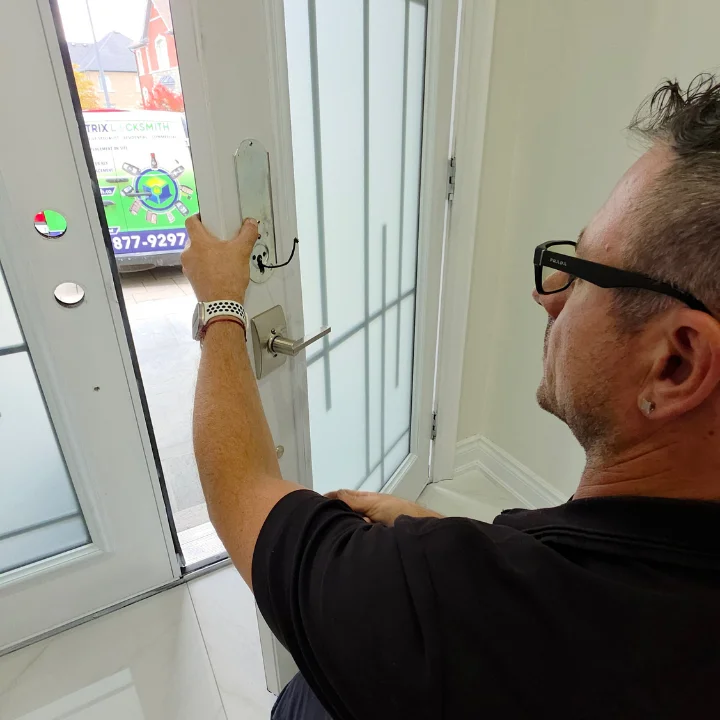
I’ve been working on doors and locks across Richmond Hill long enough to know this, most people think their locks are what keep them safe. And don’t get me wrong, a strong lock does matter. But what’s surprising is that a lot when break-ins happen, it’s not the lock that gives out first, it’s the door frame.
You can have the most expensive deadbolt, but if your frame isn’t built or reinforced properly, it can split with a single hard kick. That’s why when I do security checks for homes around here, I always start by inspecting the frame. It tells me right away how much real protection you have.
So, let’s walk through what I usually look for when checking if a door frame can actually hold up against forced entry.
The Door Frame Is Your First Line of Defense
When I say “door frame,” I’m talking about the entire structure that holds the door in place, the jamb, the strike plate area, and even the surrounding studs behind the trim. Most homes in Richmond Hill have wooden doors. They may look nice and feel solid, but they can easily split under pressure when untreated or weak.
Remember, your lock is only as strong as what it’s anchored to.
Step 1: Take a Closer Look at What Your Door Frame’s Really Made Of
How do I start checking doors? By giving the frame a gentle knock. A solid hardwood frame gives off a tight, dense tone, while softer wood, like pine, sounds dull or hollow. Once you’ve done it a few times, you can almost feel which one’s built to last.
I’ve seen numerous dried and weakened door frames in Richmond Hill with wooden frames, while newer homes sometimes use engineered wood that looks sturdy but isn’t always top-grade. So before assuming your door is safe, try this quick check:
- Press your thumb or a screwdriver tip gently into the edge of the frame. If it dents easily, that wood’s too soft to handle force.
- Inspect the latch and hinge areas. Even small cracks or splits there are signs of stress.
- Run your fingers along the surface. If it feels flaky or brittle, that’s early wood fatigue.
You don’t always need a full replacement, a few reinforcements or upgraded strike plates can go a long way. Catching it early is what keeps your door strong when it matters most.
Step 2: Examine the Strike Plate — It’s More Important Than You Think
The strike plate is that small piece of metal where your deadbolt slides in. A weak strike plate with short screws is one of the most common failure points during a break-in. I’ve seen plenty of homes where the lock itself was fine, the intruder simply kicked hard enough to tear the strike plate and part of the frame right out of the wall.
Here’s what I tell homeowners:
- Remove one screw from your strike plate and check its length. If it’s shorter than 3 inches, replace it immediately.
- Use longer screws that reach deep into the wall stud, not just the frame trim.
- Install a reinforced strike plate for even better protection.
Quick, inexpensive fixes can reinforce your door substantially.
Step 3: Inspect the Hinges
A door’s hinges are valuable parts of your home security. If they’re loose, rusted, or attached with short screws, they can become another weak point. I’ve worked on doors where the hinges were literally hanging by one thread, all it takes is a few kicks for the entire thing to give way.
Here’s how to check yours:
- Open your door slightly and look at each hinge.
- Tighten any loose screws, and replace them with 3-inch screws that anchor into the wall framing.
- If you can, add hinge bolts (also called security studs). These prevent the door from being lifted out if the hinge pins are removed from the outside.
Hinge bolts are especially important for outward-swinging doors because they make it harder for intruders to simply pop the pins and remove the door entirely.
Step 4: Watch for Gaps and Shifting Alignment
One of the first things I look at during any service call is how the door actually sits in its frame. You can tell a lot just by looking at the gaps. If the space along the top or sides isn’t even, maybe it’s a bit wider near the hinge or handle, that’s usually the door’s way of telling you something’s off.
Misalignment happens slowly and can be caused by many things. Trouble starts when the bolt no longer slides cleanly into the strike plate.
Try these simple checks:
- Lock the door and wiggle the handle gently. If it rattles or feels loose, the bolt may not be locking fully.
- Look at the edges. There should be no light and no draft slipping through.
- If it’s uneven or scraping, a small hinge adjustment or reinforcement plate can often fix it before it becomes a bigger issue.
Pay attention to small gaps because they’re exactly what intruders look for.
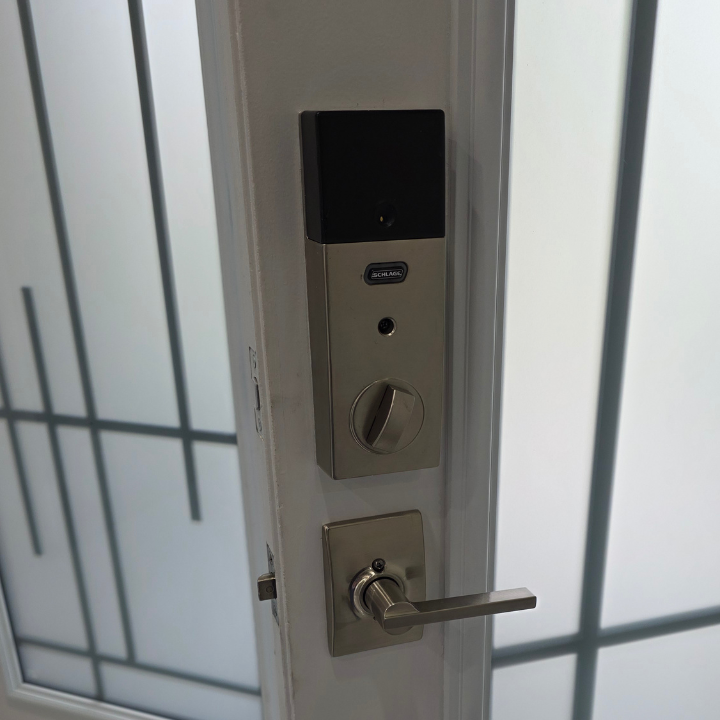
Step 5: Reinforce Weak Spots
Don’t worry if you’re on a tight budget and can’t spend money on a new frame. A few things you can do to make it tougher are:
- Add a door jamb reinforcement kit. These kits include metal plates that fit over the strike and hinge sides, distributing pressure during impact.
- Install a security bar or door brace. These provide extra support from inside and are great for entry doors without storm doors.
- Replace old screws. Swap out all short hinge and strike plate screws for 3-inch ones that grab into the studs.
These upgrades cost only a little, but they add serious resistance against forceful entry.
Step 6: Don’t Forget About the Door Itself
Even if your frame is strong, your door might not be. Hollow-core doors, especially older ones, aren’t designed to handle much impact. You can get the best protection from solid wood or steel doors. Upgrade your door if it feels light or sounds hollow when you knock.
Another excellent choice is modern fiberglass doors. They’re energy-efficient, low-maintenance, and surprisingly tough against forced entry when paired with a reinforced frame and quality lock.
Step 7: When the Weather Turns Against Your Door
If you’ve lived in Richmond Hill for a while, you already know our climate doesn’t go easy on anything made of wood. It can be freezing cold this week, but humid the next. Constant changes like these can wear down your door frame.
Here’s what usually gives it away:
- The door starts sticking during colder months — that’s the frame swelling from trapped moisture.
- You notice tiny gaps in summer — when the wood dries out and pulls back from the edges.
- Locks suddenly feel off — harder to turn or just slightly misaligned because the strike plate has moved.
- Loose screws or hinge movement — subtle signs the frame’s been warping from all that seasonal stress.
Most people don’t think much of it, but those small changes are the first sign of weakness around the lock area. If you spot them early, a quick adjustment or reinforcement can fix it before it turns into a real security issue. I’ve seen plenty of doors saved with a little care at the right time, it’s always cheaper than replacing a whole frame later.
Step 8: The Professional Touch
I always tell homeowners, you can do a lot on your own just by paying attention, but there’s a point where an expert’s eye makes all the difference. A quick inspection from a locksmith isn’t just about checking if the door closes right. We’ve got tools that can measure alignment down to the millimeter, pick up hairline cracks hiding under paint, and test how much pressure your frame can really take before it gives.
More often than not, the problem isn’t even the frame itself. A short visit from someone who knows what to look for can turn a “pretty secure” door into one that’s genuinely tough to get past. And trust me, that peace of mind is worth way more than the quick check it takes to get there.
Security Starts with the Frame
I always tell homeowners that their lock is only as strong as the frame it’s sitting in. The frame plays a major part. It’s what absorbs the impact when someone tries to force their way in, and it’s what keeps your lock anchored tight when you turn that key.
Don’t do what’s popular and rush to spend money on the latest tech. It’s all for naught if your door frame isn’t in top condition. Take a step back and pause. Perhaps all you need to do is reinforce the frame.
Let’s Make Sure Your Door Can Take It
If you’re uncertain about your door frame, give me a call at (416) 877-9297. I can stop by, inspect it in person, and show you exactly where your weak points are, no guesswork, no pressure.
At Matrix Locksmith, we’ve helped hundreds of Richmond Hill homeowners strengthen their doors and prevent costly damage before it happens. Because real security isn’t about fancy gadgets, it’s about solid, reliable protection that you can feel every time you lock your door.




